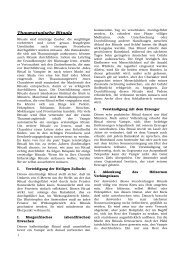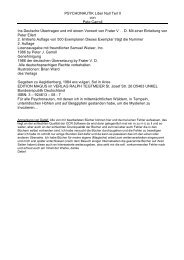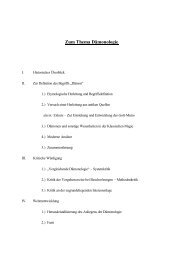CHAPTER 2 CHAPTER 3 CHAPTER 1 CHAPTER 2 CHAPTER 3 ...
CHAPTER 2 CHAPTER 3 CHAPTER 1 CHAPTER 2 CHAPTER 3 ...
CHAPTER 2 CHAPTER 3 CHAPTER 1 CHAPTER 2 CHAPTER 3 ...
You also want an ePaper? Increase the reach of your titles
YUMPU automatically turns print PDFs into web optimized ePapers that Google loves.
<strong>CHAPTER</strong> 2 14<br />
electrons and other particles which emit quanta of energy. Some are detected by special photography as the<br />
four known fields of vibration around the human body and the atomic and molecular structures of various<br />
crystalline bodies as obtained by the British physicist, W. L. Bragg. The kind of motion that these shells<br />
exhibit, determines what the effect of that energy is to be. Heat, for example, is a wave pattern made up of a<br />
series of particles given off in quanta by an electron. It might be called pure energy moving with a peculiar<br />
kind of motion. The nature of the motion determines the effect produced, which can be any of the following:<br />
Nonvisible light; visible light measured as heat, or cold light. Remember that visibility and invisibility and the<br />
sensations of heat and cold are only sensations of the physical structure. Thus the real meaning of the term<br />
light is far beyond what is visible to the eyes. The term light is used to designate the wave nature of all matter,<br />
its energy and its motion.<br />
(2) In order for bodies continually to discharge energy they must continually absorb a new supply of energy.<br />
Thus the Universe consists of constant interchange of energy resulting in:<br />
(3) A perpetual rhythmic expansion and contraction. For example, it is only possible for comets to travel at<br />
their terrific speeds for long periods of time because they are constantly replenishing their energy through<br />
their tail, and this energy is from a sun.<br />
Now let us consider the tremendous likenesses exhibited by primary bodies beginning with the smallest we<br />
can detect, the sub-atomic:<br />
Sub-atomic particles (and when we say particle, we must think of particle-wave for the two concepts are<br />
inseparable in speaking of basic structure) are to be considered in this discussion as particles that science can<br />
know only indirectly by their behavior Thus, heat energy given off by an electron might be comparable to<br />
satellites of the electron. Thus the electron gives off electro-magnetic radiation, which produces effects on<br />
varying portions of the spectrum depending on the kind of motion.<br />
Perhaps these particles are those quanta of electromagnetic radiation which have been called photons and/or<br />
gamma rays. These rays, like X-rays, are without an electrical charge and are therefore not deflected in<br />
electric or magnetic fields. Gamma rays are electro-magnetic radiation of very short wave length, and high<br />
energy. Photons or energy vary in their velocity and thus energy according to the kind of radiation to which<br />
the matter emitting the photons is subjected.<br />
If the radiation is in the high frequency end of the spectrum, then the photons will have a higher energy. In<br />
other words, the energy of the photons emitted by an electron subjected to electromagnetic radiation is related<br />
to the energy of the radiation, but the energy is emitted in distinct quanta. Photons are too small to detect<br />
experimentally in the high frequency portion of the spectrum. They are only detected in that part of the<br />
spectrum below visible light.<br />
Photons or gamma rays by interaction with atomic nuclei have been converted into pairs of electrons and<br />
positrons (positively charged electrons). This materialization is a good example of the equivalence of matter<br />
(mass) and energy.<br />
Scientists have divided the sub-atomic particles into two classes. The first class consists of particles which<br />
cannot occupy the same shell or energy level. These include the proton, electron, positron, neutron, neutrino<br />
and mu mesons. The second class consists of particles which can occupy the same energy level. Photons,<br />
gravitons, and pi mesons be-long to this class. The graviton is the unit of gravitational energy. According to<br />
the Unified Field Theory, gravity is just another aspect of electromagnetism like light, radio waves and other<br />
forms of electro-magnetic radiation.<br />
Professor Vaclav Hlavaty of Indiana University Graduate Institute of Applied Mathematics recently achieved<br />
solutions to mathematical equations in Einstein's latest Unified Field Theory that revolutionize our concepts






